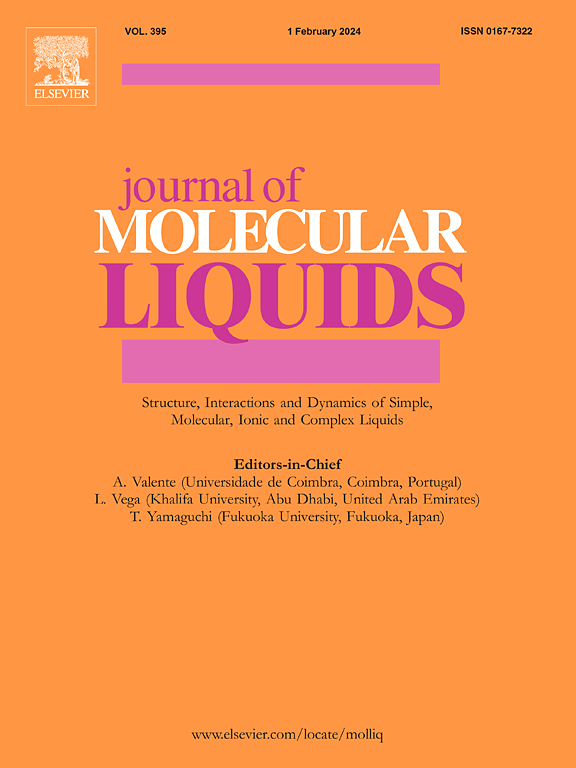Local structure and mobility in melts of ionic liquids-selected primary and secondary alcohols
IF 5.3
2区 化学
Q2 CHEMISTRY, PHYSICAL
引用次数: 0
Abstract
We present the results of a systematic study of the influence of isomerism of selected primary and secondary alcohols on their processes of solvation in dimethylimidazolium (dmim+) chloride ionic liquids. The properties of this system are investigated near the melting temperature by means of the molecular dynamics method. The study of single particle tracking (SPT) trajectories plays a significant role in the present analysis of the features of the microscopic movement of molecules of the dissolved substance in the solution. We demonstrate that the isomerism of alcohol molecules in case of isobutanol and isopentanol leads to the increase of their self-diffusion coefficients due to the growth of the IL’s local structure near the solute as we move from the alcohol to its isomer. The motion of butanol/isobutanol and pentanol/isopentanol alcohols molecules in this process is determined both by the mass, and the hydrophobic properties of the solute. Conversely, we demonstrate that the motion of systems with propanol/isopropanol are determined by the structure of the solute.
离子液体--精选伯醇和仲醇熔体中的局部结构和流动性
我们系统研究了某些伯醇和仲醇的异构现象对其在二甲基咪唑(dmim+)氯离子液体中溶解过程的影响。通过分子动力学方法研究了该体系在熔化温度附近的特性。单粒子跟踪(SPT)轨迹研究在分析溶液中溶解物质分子的微观运动特征方面发挥了重要作用。我们证明,在异丁醇和异戊醇的情况下,醇分子的异构性导致其自扩散系数增加,这是因为当我们从醇移动到其异构体时,溶质附近的 IL 局部结构会增长。在此过程中,丁醇/异丁醇和戊醇/异戊醇分子的运动是由溶质的质量和疏水特性决定的。相反,我们证明丙醇/异丙醇体系的运动是由溶质的结构决定的。
本文章由计算机程序翻译,如有差异,请以英文原文为准。
求助全文
约1分钟内获得全文
求助全文
来源期刊

Journal of Molecular Liquids
化学-物理:原子、分子和化学物理
CiteScore
10.30
自引率
16.70%
发文量
2597
审稿时长
78 days
期刊介绍:
The journal includes papers in the following areas:
– Simple organic liquids and mixtures
– Ionic liquids
– Surfactant solutions (including micelles and vesicles) and liquid interfaces
– Colloidal solutions and nanoparticles
– Thermotropic and lyotropic liquid crystals
– Ferrofluids
– Water, aqueous solutions and other hydrogen-bonded liquids
– Lubricants, polymer solutions and melts
– Molten metals and salts
– Phase transitions and critical phenomena in liquids and confined fluids
– Self assembly in complex liquids.– Biomolecules in solution
The emphasis is on the molecular (or microscopic) understanding of particular liquids or liquid systems, especially concerning structure, dynamics and intermolecular forces. The experimental techniques used may include:
– Conventional spectroscopy (mid-IR and far-IR, Raman, NMR, etc.)
– Non-linear optics and time resolved spectroscopy (psec, fsec, asec, ISRS, etc.)
– Light scattering (Rayleigh, Brillouin, PCS, etc.)
– Dielectric relaxation
– X-ray and neutron scattering and diffraction.
Experimental studies, computer simulations (MD or MC) and analytical theory will be considered for publication; papers just reporting experimental results that do not contribute to the understanding of the fundamentals of molecular and ionic liquids will not be accepted. Only papers of a non-routine nature and advancing the field will be considered for publication.
 求助内容:
求助内容: 应助结果提醒方式:
应助结果提醒方式:


